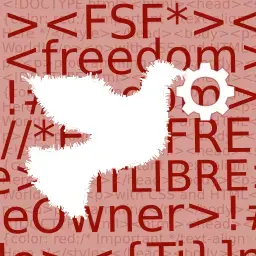You could if you want fork from when it was GPLv3: https://github.com/stenzek/duckstation/commit/7f4e5d55dbdef5a50e0aa4994f667fb03d854928
Alex
FLOSS virtualization hacker, occasional brewer
- 13 Posts
- 497 Comments
From the linked comment it sounds like there was a license change in the projects history. I’m surprised the various distro packagers didn’t just collaborate on a renamed fork, unless there are more actively developed emulators still under a FLOSS licence?
Edit yep it was GPLv3 about 11 months ago: https://github.com/stenzek/duckstation/commit/7f4e5d55dbdef5a50e0aa4994f667fb03d854928
I’ve moved to using Rama Lama mainly because it promises to do the probing to get the best acceleration possible for whatever model you launch.

 1·5 days ago
1·5 days agoI’ve got an Ampere workstation (AVA) which from a firmware point works fine. They may even fix the PCIe bus on later versions.

 4·5 days ago
4·5 days agoAsahi is a powerful example of what a small well motivated team can achieve. However they are still face the sisyphean task of reverse engineering entirely undocumented hardware and getting that upstream.
If you love Apples hardware then great. Personally when I have Apple hardware I just tweak the keys to make it a little more like a Linux system and use brew for the tools I’m used to. If I need to I can always spin up a much more hackable VM.

 1·5 days ago
1·5 days agoArm has been slowly pushing standardisation for the firmware which solves a lot of the problems. On the server side we are pretty much there. For workstations I’m still waiting for someone to ship hardware with non-broken PCIe. On laptops the remaining challenge is power usage parity with Windows and the insistance of some manufacturers to try and lock off EL2 which makes virtualization a pain.
Sorry to hear that. Good luck finding a new gig without needing to interact with Teams again.
I used to update my tickets from Emacs org-mode where I kept my working set off knowledge. The org export functions dealt with whatever format Jira expects. Nowadays I’m mostly tracking stuff so my comments are generally never more than a “thanks”, 👍 or occasionally a link to the patch series or pull requests.
Jira is alright, not great, not terrible. You need something to track projects and break down work and say least being ubiquitous a lot of people are familiar with it.
Teams is a dumpster fire of excrement though.

 2·22 days ago
2·22 days agoThe article implies they were already on AWS so this migration was from Xeon instances to Arm Graviton instances. I wonder how much of the AWS fleet is Arm now?
Edit to add apparently RDS and Aurora are two different database hosting solutions in the AWS service zoo.
What do the inputs and configuration drop down menus say?
Why would you? Effectively you are storing the address of the address at the address. It would get more complicated if there where post/pre increments or index offsets involved.
I remember the old ADSL modems where effectively winmodems. I had to keep a Windows ME machine as my household router until the point the community had reversed engineered them enough to get them working on Linux.
At least they where usb based rather than some random card. I think the whole driver could work in user space.

 3·1 month ago
3·1 month agoI’d be wary of switching to a non-free license. The freedom to use for whatever is fairly core to the four freedoms. However all the main licenses specify the code is as-is and it’s perfectly fair for the maintainer not to take on the unpaid burden on behalf of others making money with their work.

 2·2 months ago
2·2 months agoI remember when this guy came to power and the allegations of extra-judicial executions as part of his war on drugs. I didn’t realise the ICC had caught up with him.

 27·2 months ago
27·2 months agoWow - bonkers to have a warship that might not be able to feed its crew should it be in a war situation when they can’t get the approved contractors onboard.

 3·2 months ago
3·2 months agoVirtIO was originally developed as a device para-virtualization as part of KVM but it is now an OASIS standard: https://docs.oasis-open.org/virtio/virtio/v1.3/virtio-v1.3.html which a number of hypervisors/VMM’s support.
The line between what a hypervisor (like KVM) does and what is delegated to a Virtual Machine Monitor - VMM (like QEMU) is fairly blurry. There is always an additional cost to leaving the hypervisor to the VMM so it tends to be for configuration and lifetime management. However VirtIO is fairly well designed so the bulk of VirtIO data transactions can be processed by a dedicated thread which just gets nudged by the kernel when it needs to do stuff leaving the VM cores to just continue running.
I should add HVF tends to delegate most things to the VMM rather than deal with things in the hypervisor. It makes for a simpler hypervisor interface although not quite as performance tuned as KVM can be for big servers.

 2·2 months ago
2·2 months agoNo the Apple hypervisor is called hvf, but projects like rust-vmm and QEMU can control and service guests run on that hypervisor. No KVM required.












In my first interview they put me in a room with a PC with Borland C and a copy of K&R and a sheet with a simple problem to solve and some extra enhancements if I had time. They said they would be back in half an hour and left me to it. That I passed fine.
Some twenty-ish years later I was asked to write a C function to reverse a string on a white board and I failed because I’d misformatted the for loop. I don’t think it was because I’ve become a worse C coder in the intervening years.
When I’m actually coding I’m sat with my editor configured Just So with completion, compilation and unit tests at my finger tips. My favourite coding music blasting my speakers and a handy browser window for looking up anything in unsure of. This is my most productive setting and expecting the same performance in a stressful interview setting is foolish in my opinion.
Working through problems on a white board can work well but you are looking for the problem solving approach, not an encyclopedic knowledge of regex syntax. Those same problems get immeasurably harder when explained over a phone call.
My personal preference when evaluating candidates ability to code is reading their actual production code, the break down of commits, the commit messages and the sort of unit tests they add with a feature. The interview is more focused on their soft skills, what about the work excites them and what they are looking to get out of the role.